Excerpts from Jim Conrad's
Naturalist Newsletter
from the May 4, 2019 Newsletter issued from Rancho Regensis north of Valladolid, Yucatán, MÉXICO;
elevation ~40m (~130 ft), N~20.876°, W~88.170°
MELLEO VINE
Along a cow trail through the woods here on the ranch, this week a certain treetop-climbing woody vine, or liana, suddenly adorned itself with bright yellow, trumpet-shaped flowers, a small part of which is shown below:

A closer look at the flowers show that their corolla tubes nod downward where they issue from their calyxes, and the face made by the corolla lobes compensates for the nod by tilting its top backwards, as seen below:
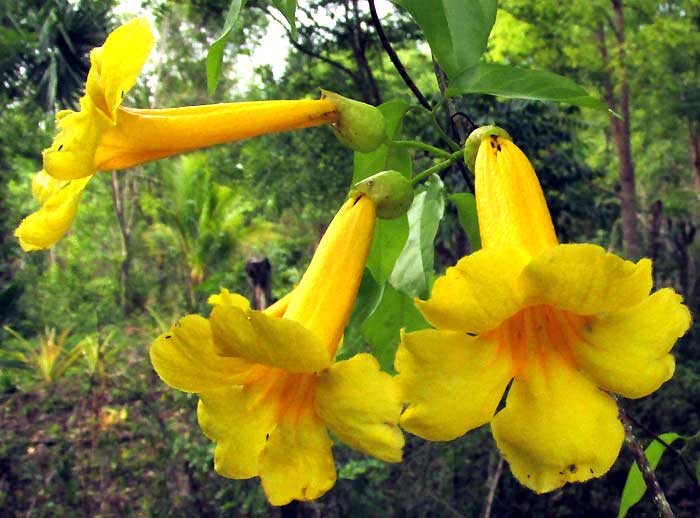
The corolla is neatly designed for pollinators such as fair-sized bees, as seen below:
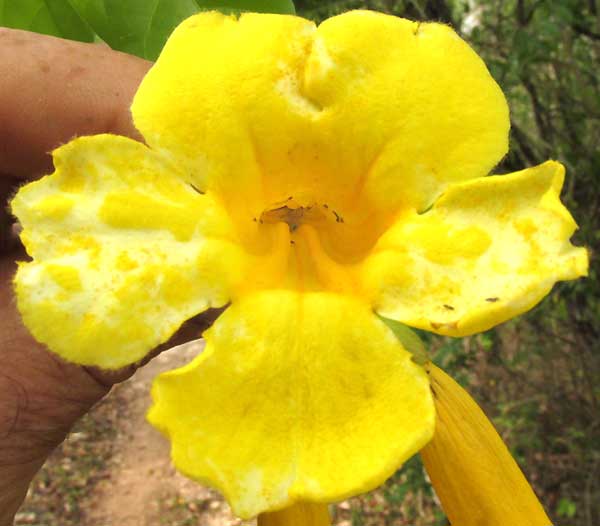
You can see that the bottom corolla lobe makes a nice landing pad for pollinators, and ridges on the corolla tube's floor guide toward nectar down below. Pressed against the corolla tube's ceiling are four stamens whose anthers daub pollen atop any entering pollinator. Once the flowers are pollinated, the corollas fall off, brightly littering the ground, and on the stems leaving conspicuous stigma-tipped styles poking from the green, bladdery calyxes, as shown below:

The calyxes are unusual not only because they are so large and bladdery, but also because they open at an oblique angle, with the upper side elongating to a slender point, as shown below:
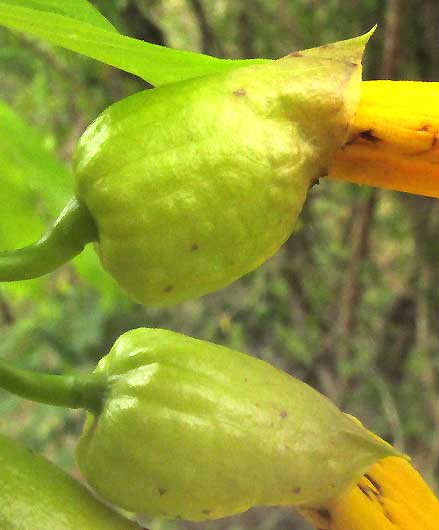
Here toward the end of the hottest, driest part of the dry season, when many trees are leafless and the herbaceous layer is mostly dead or shriveled up, our cow-path liana is issuing surprisingly fresh, tender-looking leaves, each leaf consisting of two leaflets, seen below:
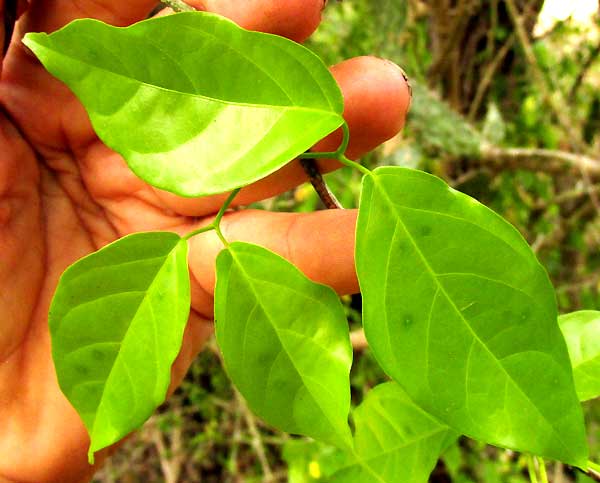
Woody stems from previous years secure the liana's stems in place with woody tendrils that wrap around their host tree's stems, shown below:
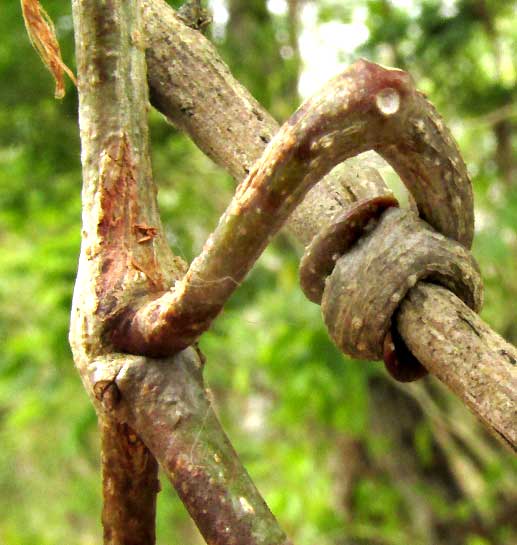
In that picture, notice at the top of the tendril's arch there are two scars. Those scars are where a previous season's two leaflets fell off. In this species, then, tendrils develop between the two leaflets, as seen below, at the tip of an elongating stem:
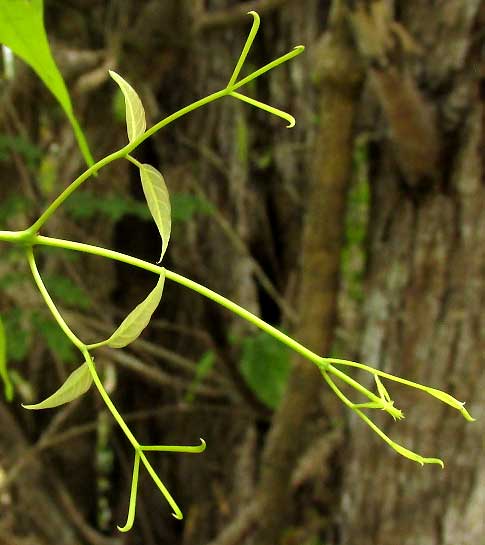
Note that the tendrils produce three sharply clawed appendages that reach out for support like three clawed toes. Many new leaves bear no tendrils.
Despite all the above excellent field marks, this liana can be confused with other species in the area. For example, a commonly occurring liana with very similar flowers that also suddenly appear ("big bang" flowering ), and with very similar three-clawed tendrils is Cat-claw, Macfadyena uncata. However, two of the above field marks disqualify our cow-trail liana from being that species. First, Cat-claw's calyx opening isn't oblique, and its top side doesn't elongate into a tooth. An even more telling feature is shown below:
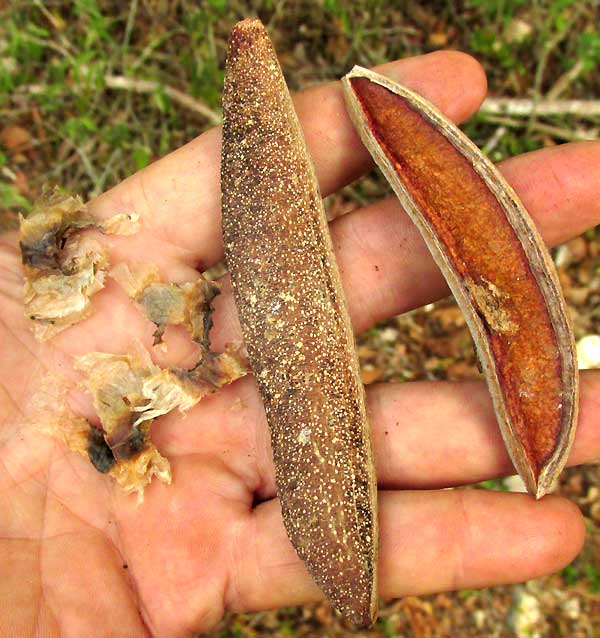
The ground below our liana was littered with last season's dropped capsular fruits. In the picture, paired seeds bearing papery "wings" to help with wind dispersal are seen at the left, while the two larger items on the right are split-apart sides from two different fruits. Cat-claw's fruits are very slender -- up to 27cm long (10 inches) but only about 18mm wide (1¾ inch). Our cow-trail fruits are shorter and wider, only up to about 15cm long (6 inches) but to about 5cm wide (2 inches)
The calyxes and fruits point to MELLOA QUADRIVALVIS*, which could as easily be called Cats-claw as the Macfadyena, but I can't find anyone calling it that, so I think of it as the Melloa vine, which is a pretty enough name. Mello quadrivalvis occurs throughout southern Mexico south through Central America to southern Brazil and northern Argentina.
Little other information is given about it on the Internet. But I can say that when Melloa quadrivalvis undergoes its Big Bang flowering time during the hottest, most dried-time of the dry season, it's a grand thing to behold.